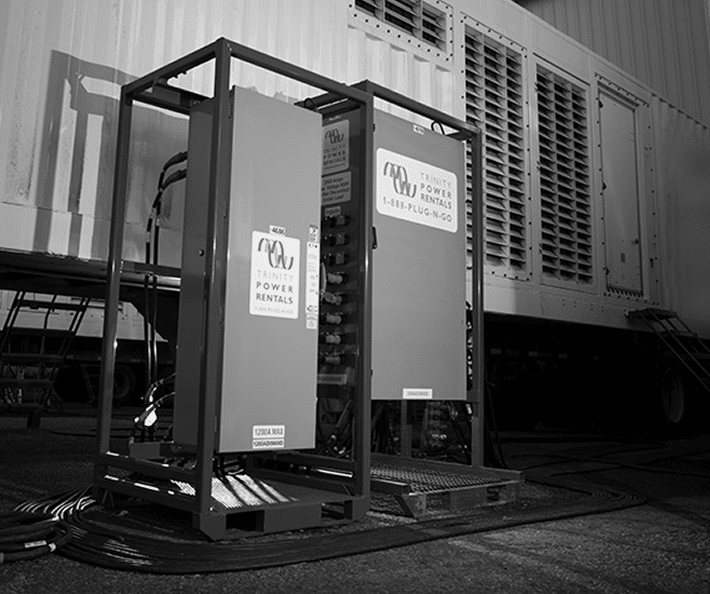- OUR APPROACH
-
COMMITTED TO YOUR SUCCESS
Our approach, developed over decades of experience, is fine-tuned to get the results you want.
We deliver concept-to-completion solutions, designed by temporary power specialists with access to the largest inventory of high-quality power generation and distribution equipment in North America.
-
- Equipment
-
RENTALS
From a wide range of diesel and natural gas generators to transformers, cable, light towers and more, our large rental fleet and extensive vendor network ensure we’ll have the temporary power equipment that your project requires — every time.

-
- Industries
-
INDUSTRIES WE SERVE
For nearly 20 years, we have been at work powering projects across Canada’s industrial sectors.
Select from this sampling of industries to learn how we can put our expertise to work for you.
VIEW ALL- Projects
- About
-
A PROUD HISTORY. A BRIGHT FUTURE.
From our inception in 1998, we have been building our team on a foundation of excellence. Our team members’ passion, expertise and commitment are what have allowed us to grow into a national company with projects across Canada.
Click on the links to learn more about our history, our team or our career opportunities.
- Blog
- Contact
-
Loss of time, loss of revenue. It’s easy to equate a site shutdown with loss. But it doesn’t have to be that way. With the right planning and execution, an efficient, properly powered shutdown is possible.
At Trinity Power Rentals, we are no strangers to shutdowns. Neither is our team.
We sat down with our resident experts, Kurt Guess, Jordan Maryniuk and Konrad Sander, to talk about the power-related aspects of a shutdown: how to prepare, what to avoid, and how to ensure you keep operating with minimal losses.
We also asked shutdown expert, Andy Maharaj, to weigh in with his top shutdown advice.
What are shutdowns and why do they happen?
Plants, mills, commercial buildings—any site that uses electrical equipment—are all candidates for a shutdown. “Like an oil change on your car, service and continued maintenance on any electrical or mechanical equipment is necessary to continue and extend the lifetime in operation,” explains Guess.
In a best-case scenario, this maintenance is scheduled to happen outside business hours, so that it doesn’t affect regular operations. However, in some cases, for example at sites that operate 24/7, measures need to be in place to ensure that business is able to go on as close to usual as possible.
In a worst-case scenario, the shutdown is unplanned, resulting from improper maintenance or unforeseen circumstances, and can lead to huge losses of time and money.
In both scenarios, adequate preparation is the best safeguard against loss.
What is the best way to prepare for a shutdown?
Preparing for a shutdown is all about planning. “Determine load requirements, prepare for variables in cable lengths and have your equipment provider map out a detailed plan,” says Maryniuk. Sander adds, “Make sure that all of the equipment is sent out and installed on time, the generator is fueled and remains that way for the duration of the shutdown.”
Equipment isn’t the only thing you should be planning for. Guess explains, “It’s crucial to discuss the requirements of all the people and trades involved in the shutdown.”
“You can never plan enough for a shutdown as far too many variables come into play that make the shutdown unique. The key is to create a detailed (hour by hour) library plan for the maintenance of your equipment. Once the plan is created you can always take a copy of that plan and modify to suit the conditions that have occurred. A detailed plan will also allow you to resource balance the work and to create a trackable execution plan.” -Andy Maharaj, President, The T/ASC Planning Group, Speaker, 2016 Shutdowns Superconference.
What is the best way to respond to an unplanned shutdown?
Guess and Maryniuk agree that having your emergency contacts readily available is a key factor in handling an unplanned shutdown. “Having either a contingency plan in place or having the right contacts at your fingertips that know how to react quickly is critical to ensure minimal downtime and potential loss in revenue,” says Guess.
With a plan in place, power equipment becomes a key consideration: “[Have your temporary power specialist] send the items that will require the most setup time right away,” explains Sander. “For example, get the cable on site so the onsite workers can have it all ready to hook up when the generator arrives.” He continues, “At Trinity Power, we will simultaneously arrange the freight vendor to pick up the generator rental from whichever company has the quickest response time, to ensure there is minimal down time.”
What can happen when a shutdown goes wrong?
When a shutdown happens and a site hasn’t properly prepared, the result can be summed up in one word: loss. “There are financial liabilities for not being prepared,” explains Maryniuk.
Guess elaborates, “Usually excessive time waste would be the largest cost. However, not properly planning ahead can mean that the right equipment or people providing services aren’t available.” Unforeseen freight charges, prolonged downtime, loss in production and excess man hours are just a few of the ways this kind of poor planning can translate into a big financial hit.
What’s the Bottom Line?
When it comes to both scheduled and unexpected shutdowns, planning is key.
If you’re anticipating a scheduled shutdown, have a detailed plan in place, ensuring that everyone is on board, and all the equipment you need is ready to go.
If you’re not planning a shutdown, that’s no guarantee you won’t have one. Be prepared with an emergency plan outlining who you need to contact, and what needs to be done to get back up and running safely, and as quickly as possible.
Related Articles
Subscribe for Access to Exclusive Content
Get insider updates, industry news, special equipment offers, and expert tips—directly to your inbox.
"*" indicates required fields





















